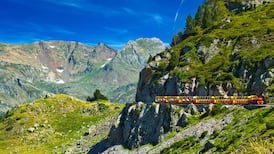When Carl Clancy and Walter Storey breezed into Paris in late November 1912, during all the time they stayed there – about two months – they saw only five other motorcycles. "For some strange reason, they [are] decidedly unpopular here," Clancy told readers of the
Bicycling World and Motorcycle Review
of New York.
Would that he could see the place now. . .
Swarms of motorcycles, as though emerging from a disturbed bee hive, lead the charge from every set of traffic lights. And if you thought Dublin cyclists paid scant attention to other road users and pedestrians, they’re nothing compared to the high-pitched Parisian scooters that zip in and out of traffic, through pedestrian crossings and along pavements, scattering all before them.
When Clancy and Storey reached Paris on their pioneering around-the-world bike ride, they got their Hendersons into a warehouse for 80 cents a month and promptly set about sampling the city’s delights.
They went to the Moulin Rouge on the Pigalle, where slightly risque young women disported themselves on stage with ostrich feathers and not a lot else. The cancan and its tantalising display of stockings and knickers was also performed.
Clancy and Storey also saw what Clancy described as “cabaret artistique” in the Chat Noir, the Montmarte cafe immortalised by Theophile Steinlen’s wonderful 1896 poster for a tour by the cafe’s troupe of entertainers.
And they went to Le Rat Mort, the absinthe-soaked cafe-restaurant in the Pigalle that catered for lesbians and was also favoured by Harry Kendall Thaw, the notorious US coal and railroad heir who threw lavish parties in Paris and blew a fortune on prostitutes and drugs. In 1985, he took over a floor of the George V hotel and blew $50,000 on having a good time with 25 hookers, supported by a marching band.
The Chat Noir has had a few incarnations; the one visited by Clancy was on Rue Victor-Masse and needless to say does not exist today. A pale imitation sports the name but not the spirit. The Rat Mort is also, well, dead, and Geoff, Gary and I have no intention of blowing €175 on the Moulin Rouge!
Clancy was enthused by the place and loved what he called the “vigorous, throbbing life” of Paris and its citizens. He did not restrict himself to the late night delights of Montmarte and the Pigalle; he also went to museums and churches and what he called monuments to the revolution.
What interested me most about his sojourn in Paris was his hotel because it has extraordinary Irish connections.
Clancy stayed at the Grand Hotel Corneille, 5 rue Corneille near the Luxembourg Gardens on the city's avant garde Left Bank and grand only in name, as he reported.
This was the hotel where, in 1896, aspirant Irish playwright John Millington Synge met poet WB Yeats. "Give up Paris," advised Yeats. "You will never create anything by reading Racine, and Arthur Symons will always be a better critic of French literature. Go to the Aran Islands. Live there as if you were one of the people themselves; express a life that has never found expression."
He remembered Synge as the “poor Irishman at the top of the house”.
“I was very poor,” Yeats wrote later, “but he was much poorer. He belonged to a very old Irish family and though a simple courteous man, remembered it and was haughty and lonely. With just enough to keep him from starvation and not always from half-starvation, he had wandered about Europe, travelling third-class or upon foot . . . He was the man that we needed because he was the only man I have ever known incapable of political thought or of a humanitarian purpose.”
Another Irish resident was James Joyce, who lived in the Corneille from December 1902 to April 1903. He too met Synge, in March, and was given a copy of Riders to the Sea to read. Joyce was unimpressed.
“I do not care for it [Synge’s work] for I think that he wrote a kind of fabricated language as unreal as his characters were unreal,” he said.
Joyce spent much of his time in Clancy's hotel writing letters . . . many of them seeking work in
The Irish Times
.
Tomorrow: Joyce's Paris and that elusive career with
The Irish Times
.












